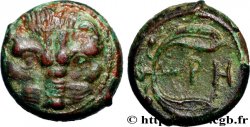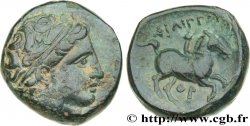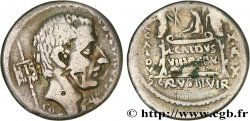v47_0017 - BRUTTIUM - REGIO Tétradrachme
MONNAIES 47 (2011)
Precio de inicio : 9 500.00 €
Valoración : 15 000.00 €
Precio realizado : 9 500.00 €
Número de ofertas : 1
Oferta más alta : 9 500.00 €
Precio de inicio : 9 500.00 €
Valoración : 15 000.00 €
Precio realizado : 9 500.00 €
Número de ofertas : 1
Oferta más alta : 9 500.00 €
Tipo : Tétradrachme
Fecha: c. 415/410 - 387 AC.
Nombre del taller / ciudad: Bruttium, Rhégium
Metal: plata
Diámetro: 25 mm
Eje de acuñación: 5 h.
Peso: 16,65 g.
Grado de rareza: R3
Comentarios sobre el estado de conservación:
Exemplaire sur un petit flan épais, parfaitement centré des deux côtés d’un style fantastique, de très haut relief. Masque de lion fantastique. Revers finement détaillé de haut relief. Jolie patine grise avec des reflets métalliques dorés, légèrement granuleuse au revers
N° en los catálogos de referencia :
Anverso
Titulatura del anverso: ANÉPIGRAPHE.
Descripción del anverso: Masque de lion vu de face ; grènetis perlé circulaire.
Reverso
Descripción del reverso: Tête laurée d’Apollon à droite, la chevelure élégamment disposée ; derrière un rameau d’olivier avec deux feuilles ; grènetis linéaire circulaire.
Leyenda del reverso: RHGINON
Traducción del reverso: (de Rhégium).
Comentario
Poids léger. Mêmes coins que l’exemplaire du Cabinet des médailles de la BnF, collection de Luynes, n° 794 et que l’exemplaire de la collection Valton, n° 108 que l’exemplaire de la collection Montagu (Sotheby, 1896), n° 81 que l’exemplaire du British Museum, collection Payne Knight et que celui du Fitzwilliam Museum de Cambridge (SNG. n° 849). C’est le dixième exemplaire recensé. Il pourrait s’agir de l’exemplaire signalé dans le commerce en 1949 (Dr. Jacob Hirsch), mais nous n’avons pas d’indication de poids. En dehors de l’exemplaire du British Museum qui pèse 16,76 g, tous les autres exemplaires ont un poids supérieur (entre 17,18 g et compris jusqu’à 17,40 g). Nous n’avons pas de liaison de coin avec d’autres exemplaires de la série. Il s’agit de l’ultime tétradrachme du classement de Herzfelder avant la destruction de la cité par Denys l’Ancien en 387 avant J.-C.
Light weight. Same dies as the example in the Cabinet des médailles of the BnF, Luynes collection, no. 794 and the example in the Valton collection, no. 108, as well as the example in the Montagu collection (Sotheby, 1896), no. 81, as well as the example in the British Museum, Payne Knight collection and that of the Fitzwilliam Museum in Cambridge (SNG. no. 849). This is the tenth example recorded. It could be the example reported in trade in 1949 (Dr. Jacob Hirsch), but we have no indication of weight. Apart from the example in the British Museum which weighs 16.76 g, all the other examples have a higher weight (between 17.18 g and up to 17.40 g). We have no die connection with other examples in the series. This is the last tetradrachm in Herzfelder's classification before the destruction of the city by Dionysius the Elder in 387 BC.
Light weight. Same dies as the example in the Cabinet des médailles of the BnF, Luynes collection, no. 794 and the example in the Valton collection, no. 108, as well as the example in the Montagu collection (Sotheby, 1896), no. 81, as well as the example in the British Museum, Payne Knight collection and that of the Fitzwilliam Museum in Cambridge (SNG. no. 849). This is the tenth example recorded. It could be the example reported in trade in 1949 (Dr. Jacob Hirsch), but we have no indication of weight. Apart from the example in the British Museum which weighs 16.76 g, all the other examples have a higher weight (between 17.18 g and up to 17.40 g). We have no die connection with other examples in the series. This is the last tetradrachm in Herzfelder's classification before the destruction of the city by Dionysius the Elder in 387 BC.








 Informar de un error
Informar de un error Imprimir la página
Imprimir la página Comparte mi selección
Comparte mi selección Haz una pregunta
Haz una pregunta Consignar / vender
Consignar / vender
 Descriptivo
Descriptivo













